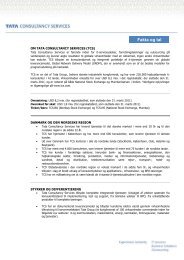TCS Corporate Sustainability Report 2010-11 - Tata Consultancy ...
TCS Corporate Sustainability Report 2010-11 - Tata Consultancy ...
TCS Corporate Sustainability Report 2010-11 - Tata Consultancy ...
Create successful ePaper yourself
Turn your PDF publications into a flip-book with our unique Google optimized e-Paper software.
level of the larger economy and thus, we can claim a role in a transformational phase of the<br />
global economy, marked by significant productivity gains from the deployment of IT.<br />
The productivity benefits from our IT-related work directly translate into community benefits<br />
when we engage with various governments to digitize their operations, that too in the area of<br />
citizenry services. The level of transparency, access and empowerment that these initiatives can<br />
create in communities can never be overstated. We do not believe that any part of our<br />
operations has a potential or actual negative impact on the communities we work in.<br />
Secondly, our profitable global operations result in payment of the applicable corporate taxes<br />
in multiple countries, helping fund the governments there and thereby improving the quality<br />
of civic services in those jurisdictions. Tax expense relating to overseas operations is<br />
determined in accordance with tax laws applicable in countries where such operations are<br />
domiciled and provided for. In FY 20<strong>11</strong>, <strong>TCS</strong> provided for a total tax expense of $465.3 Mn,<br />
distributed across 50 countries.<br />
Direct and Indirect Employment<br />
<strong>TCS</strong>’ strategy of a distributed delivery capability, tapping into the local talent in each of our<br />
delivery locations has resulted in a largely balanced, positive economic impact in each of those<br />
locations through employment generation – direct and indirect. Direct employment results in<br />
the creation of a few tens of thousands of high-paying, white-collar jobs, broadening the tax<br />
collections at the local, state and central levels.<br />
And then there is indirect employment. Each of our delivery centers, housing a few thousand<br />
employees are massive and their construction employs architects, engineers and hundreds of<br />
construction workers. Once the facility is commissioned, the center opens up tremendous local<br />
employment opportunities for workers with all kinds of skills as our vendor-partners begin to<br />
hire housekeeping staff, security guards, drivers, gardeners, maintenance workers, chefs,<br />
cafeteria staff etc.<br />
The creation of all these jobs, direct and indirect, at one location, creates a massive demand<br />
for local housing there, sparking a secondary real-estate boom in residential properties<br />
with multiple projects coming up, employing hundreds of skilled and unskilled construction<br />
workers.<br />
Moreover, the beneficiaries of these net new jobs are often young (median age of the<br />
workforce: 28 years) and therefore tend to display high consumption patterns, benefiting local<br />
businesses and by extension, the local economies. The spending behavior and consumption<br />
patterns of our employees open up tremendous business and entrepreneurial opportunities.<br />
Banks set up branches or ATMs to service this highly attractive demographic. Small businesses<br />
come up in the vicinity to supply all varieties of services and products – restaurants, grocers,<br />
departmental stores, gyms, pharmacies etc. These in turn generate even more local<br />
employment and opening up new tax revenues for the government.<br />
15<br />
All in all, it is conservatively estimated that we generate 4 indirect jobs for every 1 direct job .<br />
Taking these indirect jobs into account, <strong>TCS</strong>’ consolidated, global employment footprint is<br />
estimated at over 800,000.<br />
Infrastructure Development<br />
The coming up of new communities around our delivery centers is also accompanied by<br />
development of the local infrastructure. Local municipalities and utilities respond to the needs<br />
of the growing community by improving existing roads and building new ones to improve<br />
connectivity, extending the grid to supply electricity and laying pipelines for water and<br />
sewerage. Public and private transport providers begin catering to the commuting needs of<br />
local residents. Telecom companies set up towers nearby for mobile connectivity and cables for<br />
15 Source: NASSCOM Strategic Review <strong>2010</strong><br />
48

















